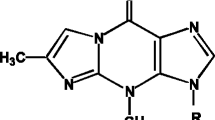Summary
In order to develop new markers of individual susceptibility to various human carcinogens, we studied some parameters of formation and metabolism of carcinogens, as well as DNA adducts formation and DNA repair in animals and humans. Following an i.p. administration of benzo(a)pyrene (BP) to the rats, levels of urinary excretion of BP-7,8-diol correlated with tumour latency. A high correlation was found between excretion of this metabolite and BP-DNA adducts level in the liver. Healthy smokers excreted higher quantities of BP-7,8-diol, than smoking lung cancer patients, thus confirming the suggestion on existence of cancer-prone phenotype. N-nitroso compounds formed most efficiently in stomach juice of children with superficial gastritis who therefore could be at high risk of stomach cancer. N-ethyl-N′-nitro-N-nitrosoguanidine induced stomach cancer earlier in monkeys with a low level of DNA repair enzyme, O6-alkylguanine-DNA alkyltransferase (AGT) in gastric mucosa. Overall, these markers can be helpful in predicting individual susceptibility to carcinogens.
Similar content being viewed by others
References
Anttila S, Hietanen E, Vainio H, Camus AM, Gelboin HV, Park SS, Heikkila L, Karjalainen A, Bartsch H (1991) Smoking and peripheral type of cancer are related to high levels of pulmonary cytochrome P450IA in lung cancer patients. Int J Cancer 47:681–685
Barrett JC, Shelby DM (1992) Mechanisms of human carcinogens. In: D'Amato R Slaga TJ, Farland WH, Henry C (eds) Relevance of animal studies to the evaluation of human cancer risk. Wiley-Liss, Inc, NY, USA, pp 415–434
Bartsch H. Ohshima H, Pignatelli B, Calmels S (1989) Human exposure to endogenous N-nitroso compounds: quantitative estimates in subjects at high risk for cancer of the oral cavity, esophagus, stomach and urinary bladder. Cancer Surv, 8:335–362
Bartsch H, Petruzzelli S, De Flora S, Hietanen E, Camus AM, Castegnaro M, Alexandrov K, Rojas M, Saracci R, Guintini C (1992) Carcinogen metabolism in human lung tissues and the effect of tobacco smoking: results from a case-control multicentre study on lung cancer patients. Environ Health Persp (in press)
Beland FA, Poirier MC (1992) Significance of DNA adduct studies in animal models for cancer molecular dosimetry and risk assessment. Environ Health Persp (in press)
Camus AM, Aitio A, Sabadie N, Wahrendorf J, Bartsch H (1984) Metabolism and urinary excretion of mutagenic metabolites of benzo[a]pyrene in C57 and DBA mice Strains. Cantinogenesis 5:35–39
Dikun PP, Ermilov VB, Shendrikova IA (1991) Some approaches to prevention of endogenous formation of N-nitrosamines in humans. In: O'Neil IK, Chen J, Bartsch H (eds) Relevance to human cancer of N-nitroso compounds, tobacco smoke and mycotoxins, IARC Sci Publ No 105 Lyon, France pp 552–557
Hams AL, Karran P, Lindahl T (1983) O-methylguanine-DNA methyltransferase of human lymphoid cells: structural and kinetic properties and absence in repair deficient cells. Cancer Res 43:3247–3252
IARC (1986) IARC Monographs on the Evaluation of Carcinogenic Risks to Humans. Vol 38 Tobacco Smoking, IARC, Lyon, France
IARC (1987) IARC Monographs on the Evaluation of Carcinogenic Risks to Humans. Supplement 7 Overall Evaluations of Carcinogenicity: An Apdating of IARC Monographs Volumes 1 to 42, IARC, Lyon, France
Kaplan EL, Meier P (1958) Nonparametric estimation from incomplete observations. J Amer Stat Assos 53:457–481
Likhachev AJ, Beniashvili DS, Bykov VJ, Dikun PP, Tyndyk ML, Savochkina IV, Yermilov VB, Zabezhinski MA (1992a) Relevance of quantitation of benzo[a]pyrene metabolites in animal excretes to evaluate individual human cancer risk. In: D'Amato R, Slags TJ, Farland WH, Henry C (eds) Relevance of animal studies to the evaluation of human cancer risk. Wiley-Liss, Inc, NY, USA, pp 435–452
Likhachev AJ, Warren BS, Slaga TJ (1992b) O6-akylguanine-DNA alkyltransferase activity in epidermal tumor and normal epidermal cells of mice of various stocks and strains. Carcinogenesis 13:1265–1268
Lohman PHM, Lauweris R, Sorsa M (1984) Methods of monitoring human exposure to carcinogenic and mutagenic agents. In: Berlin A, Draper M, Hemminki K, Vainio H (eds) Monitoring human exposure to carcinogenic and mutagenic agents. IARC Sci Publ No 59, Lyon, France, pp 423–427
Pelkonen O, Nebert D (1982) Metabolism of polycyclic aromatic hydrocarbons: etiologic role in carcinogenesis. Pharmacol Rev 34:189–222
Swann PF (1990) Why do O6-alkylguanine and O4-alkylthymine miscode? The relationship between the structure of DNA containing O6-alkylguanine and O4-alkylthymine and mutagenic properties of these bases. Mutation Res 233:81–94
Vahakangas K, Haugen A, Harris C (1980) An applied synchronous fluorescence spectrophotometric assay to study benzo[a]pyrenediolepoxide-DNA adducts. Carcinogenesis 6:1109–1116
Author information
Authors and Affiliations
Rights and permissions
About this article
Cite this article
Likhachev, A.J., Beniashvili, D.S., Bykov, V.J. et al. Biomarkers of individual susceptibility to carcinogens: Application for biological monitoring. Int. Arch Occup Environ Heath 65 (Suppl 1), S155–S158 (1993). https://doi.org/10.1007/BF00381330
Issue Date:
DOI: https://doi.org/10.1007/BF00381330



